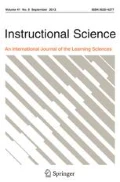Abstract
A technique is presented for partitioning N students into K groups of fixed sizes using a given measure of proximity for all student pairs. The measure of proximity is typically calculated from a set of variables, such as completed curriculum units or learning style, and constitutes the data needed for a criterion of partition “fit”. This latter index is explicitly defined by the sum of within-group proximities and when used in conjunction with the optimization procedure discussed, homogeneous groups can be obtained that satisfy externally imposed size requirements. Finally, a simple generalization is suggested for the related task of grouping students to meet upper limit size constraints only.
Similar content being viewed by others
References
Arabie, P. and Boorman, S. A. (1978). “Constructing block models: How and why,” Journal of Mathematical Psychology, 17: 21–63.
Armour, G. G. and Buffa, E. S. (1963). “A heuristic algorithm and simulation approach to relative location of facilities,” Management Sciences, 9: 294–309.
Baker, F. B., Hubert, L. J. and Schultz, J. V. (1977). Quadratic Assignment Program, Laboratory of Experimental Design, University of Wisconsin, Madison.
Belt, S. L. and Spuck, D. W. (1974). “Computer applications in individually guided education. A computer-based system for instructional management (WIS/SIM),” Working Paper No. 125. Wisconsin Research and Development Center, p. 129.
Brennan, R. L. and Light, R. J. (1974). “Measuring agreement when two observers classify people into categories not defined in advance,” British Journal of Mathematical and Statistical Psychology, 27: 154–163.
Glaser, R. H. A. (1959). “A quasi-simplex method for designing suboptimum packages of electronic building blocks (Burroughs 220),” in: Proceedings of 1959 Computer Applications Symposium, Armour Research Foundation, Illinois Institute of Technology, Chicago.
Hubert, L. (1977). “Nominal scale response agreement as a generalized correlation,” British Journal of Mathematical and Statistical Psychology, 30: 98–103.
Hubert, L. J. and Schultz, J. V. (1976). “Quadratic assignment as a general data analysis strategy,” British Journal of Mathematical and Statistical Psychology, 29: 190–241.
Katz, L. (1947). “On the matrix analysis of sociometric data,” Sociometry, 10: 233–241.
Lawrence, B. F. (1976). “Numerical procedures in the optional grouping of students for instructional purposes,” unpublished Ph.D. thesis, University of Wisconsin, Madison.
Nicholson, T. A. J. (1971). “A method for optimizing permutation problems and its industrial applications,” in: P. J. A., Welsh (ed.) Combinatorial Mathematics and its Applications. New York: Academic Press.
Rao, C. R. (1952). Advanced Statistical Methods in Biometric Research, New York: Wiley.
Rodgers, G. and Linden, J. D. (1973). “Use of multiple discriminant function analysis in the evaluation of three multivariate grouping techniques,” Educational and Psychological Measurement, 33: 787–802.
Talmage, H. E. (ed.) (1975). Systems of Individualized Education. Berkeley: McCutchon.
weisgerber, R. A. (ed.) (1971). Developmental Efforts in Individualized Learning. Itasca, Ill.: Peacock.
Witchita Public Schools. (1975). Administration of the CITE Learning Styles Instrument. Mundoch Teacher Center, Witchita.
Yates, A. (1966). Grouping In Education. New York: Wiley.
Author information
Authors and Affiliations
Rights and permissions
About this article
Cite this article
Baker, F.B., Hubert, L.J. A partitioning technique for defining instructional groups. Instr Sci 8, 121–132 (1979). https://doi.org/10.1007/BF00117007
Issue Date:
DOI: https://doi.org/10.1007/BF00117007




